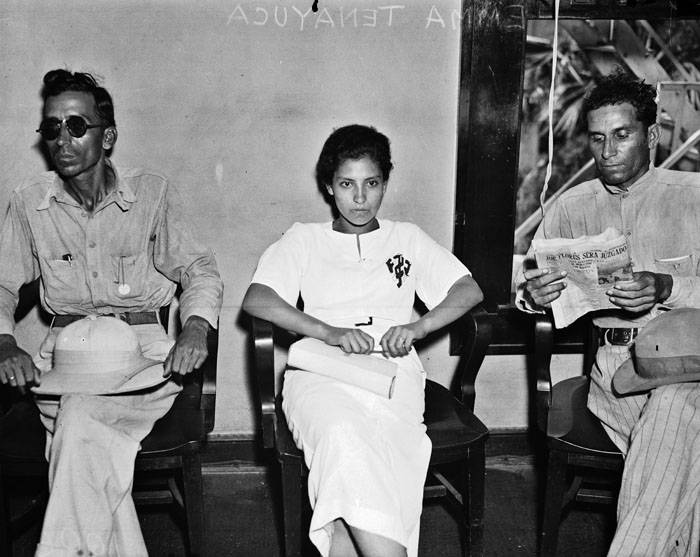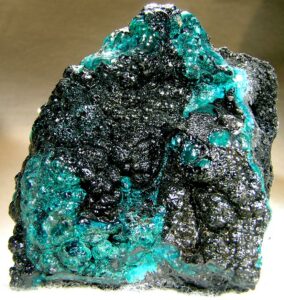Exchanging her classroom desk for the picket line, sixteen-year-old Emma Tenayuca left Brackenridge High School for the day to join hundreds of women protesting for fair wages and better working conditions.1 In the early twentieth century, before the Great Depression, San Antonio was already an oppressive place for any minority to live in, as it was a white-dominated city that was segregated according to Jim Crow social and economic policies.2 Mexicans recently immigrating from Mexico and American-born Mexican-Americans populated lower-income areas of the city, such as the Westside, which was known as the “worst slums” in the United States in the early half of the twentieth century.3 Mexican and Mexican-American women made up the majority of workers for low-paying factory jobs in the garment, cigar, and pecan shelling industries. Tenayuca’s firsthand experience on the picket line with these striking women revealed the unjust relationships between city organizations, services, and businesses, and showed how difficult liberation for Mexicans and Mexican Americans was, especially for women. Police were called to the scene of the protest to silence the strike using intimidation and violence. Police officers arrested protestors, including teenage Emma Tenayuca, with the rest of the protesters. Her experience of violence from the city authorities and her community relationships with the factory workers was the beginning of Emma Tenayuca’s fight for social justice.4

Growing up, Tenayuca spent much of her childhood with her grandparents on her mother’s side, the Zepeda family. The Zepeda family was of Spanish descent and benefited from white European privilege. In contrast, her father’s family, the Tenayuca’s, were native, or puro Indio (pure Indian). Tenayuca’s mother’s family would use the term puro Indio in a demeaning way. Throughout the twentieth century, white privilege was rampant and heavily defined individuals’ social status and conditions throughout their lives. The divide and hatred towards ethnic and racial groups influenced Mexicans of Spanish descent and those directly from Spain to believe they were superior to Mexicans and Mexican Americans of native or more native descent like Tenayuca’s father. This form of racism is also known as colorism. The complexity of race and family relations within her own community made Tenayuca well aware of racial disparities in the city, in her neighborhood, and even in her home. The Zepeda family was very politically. Her grandfather would take Tenayuca to La Plaza Del Zacate, also known as Milam Park in downtown San Antonio. Tenayuca described the plaza always to have crowds of soapbox speakers, people who would discuss political ideologies, religion, and updates from the Mexican Revolution. At the plaza, Tenayuca first heard of liberation groups that operated primarily in Mexico, such as the Magonistas. Tenayuca became connected to liberation and human rights efforts in her home city and across the border by visiting Milam Park. Additionally, she learned that the plaza was also a connection stop for Mexican migrants for finding low-paying jobs across Texas. She noticed the dire need for jobs, despite the terrible working conditions and low wages.5

The labor exploitation on the Westside continued throughout her childhood, and it even increased during the Great Depression in her young adult years. The Great Depression exacerbated the living conditions of ethnic and racial minorities. Mexican and Mexican Americans struggled to find adequately paying jobs to support themselves and their families. Most employment for ethnic and racial minorities was extremely low-paying, strenuous, and often unsafe for workers and families. The Westside of San Antonio dealt with widespread tuberculosis from poor factory working conditions and malnutrition due to low wages and lack of resources.6 The year after Emma participated in the Finck Cigar Company Factory strike, she remained active in labor protests. Her continued activism with factory workers made her realize that an unjust relationship existed between businesses, the Catholic Church, and the local government to suppress protest efforts. The relationship first appeared for Tenayuca, when people approached her with the news that the protests became a discussion during services as priests were condemning the labor rights activities and stating it was communist behavior that they should fear. The Finck Cigar Company owners, as prominent members of the Catholic Church, were able to persuade priests in San Antonio to not support any protest or strike against the Finck Cigar Company. The relationship between the Catholic Church and Finck Cigar Company became a strategy for diminishing the labor movements by intimidating Mexican and Mexican-American workers from joining protest efforts.7 The Church, local government authorities, and businesses continued their opposition efforts while anti-communists sentiment became more widespread. The opposition groups and fear of communism created obstacles for activists like Tenayuca and community organizers to advocate for civil rights. Despite the emergence of opponents and the possible threats they may pose, Tenayuca resumed her community work.8
As Tenayuca remained active with community advocacy on the Westside, her efforts grew and expanded to working with groups dedicated to labor rights. Tenayuca started by taking a role with the Unemployed Council as a relief worker. As a relief worker, Tenayuca connected jobless farmworkers to protests they could help organize and join.9 In 1935, Tenayuca became the secretary of the Westside Unemployed Council. During her position as secretary, the Unemployed Council began to merge with another labor advocacy group called the Workers’ Alliance. Under the newly combined group known as the Workers’ Alliance, Tenayuca recruited numerous members, forming chapters of the Workers’ Alliance in various areas. Tenayuca became known as a dedicated labor rights activist dedicating most of her efforts towards her Secretary position. Her frequent work and ability to appeal to working-class Mexicans and Mexican Americans earned her an elected position as General Secretary to ten chapters of the Workers’ Alliance. In 1936, Tenayuca became a member of the Communist League, expanding her political outreach and approaches to political organization.10
Undeniably, Tenayuca had quickly risen to leadership within the grassroots political and social community organizations. As Tenayuca advanced her efforts in labor movement, the industries in San Antonio continued to make conditions for workers worse. Industries responded to the economic downturn in the 1930s by neglecting the conditions of factories and cutting wages to save the company money. The massive Pecan Sheller Company, with hundreds of factories in San Antonio, implemented these tactics. The Pecan Sheller factories forced about 100 workers to work in a small building space where they had shelled pecans for hours at one long table. Contractors neglected the maintenance of factory spaces causing workers to become ill with limited or poor lighting and no ventilation to filter the pecan dust and provide clean air for workers. The majority of pecan shellers were women paid an annual income of about $251, equating to a weekly salary of a little over $2. Besides the low wages from the strenuous work, the income from pecan shelling was not steady as it was only a seasonal job. In the remaining months of the year, workers would have to find another job, which would often be farm work.11 In response, Tenayuca challenged the exploitation of the pecan shellers. On January 31, 1938, she led 12,000 pecan shellers on strike, organizing the largest labor strike in San Antonio history and largest community-based strike from Mexican and Mexican Americans.12 The Pecan Sheller Strike became an ongoing strike increasing by size each day the movement persisted. The attempts to end the strike and silence protesters was ordered by the City of San Antonio. Mayor C.K. Quin ordered police to handle the situation, which led to the mass imprisonment of protesters and brutality. The nation and parts of the world began to follow the Pecan Sheller Strike and the Mexican and Mexican-American labor protesters. Texas-elected officials began to notice the mass attention, and the Texas Industrial Commission became involved to investigate the civil rights violations claimed by protesters. By March 1938, the strikers and Pecan Sheller Company were able to agree on a wage increase.13 The pecan industry was forced to increase the minimum wage to twenty-five cents an hour. Unfortunately, the victory for factory workers did not last long as the factory implemented machines for the shelling process, eliminating the need for pecan shellers.14

After the Pecan Sheller Strike events, Tenayuca continued advocating for labor rights through her membership in the Communist Party. Her involvement with the Communist Party grew more profound in 1938 when she married Homer Brooks, an active participant in the Texas Communist Party. Tenayuca and Brooks collaborated with leadership to continue efforts in organizing labor movements on the Westside.15 Towards the end of the 1930s, the Communist Party began shifting the focus more towards an international scope relating to the Soviet Union rather than taking Communist beliefs to liberate minority people in different communities. Tenayuca believed and supported communism that centered on the voices of marginalized people and that sought to empower them; she did not care for the focus on the Soviet Union. The party’s shift towards the Soviet Union caused Americans to perceive the party as a threat to national security. The San Antonio Communist Party’s efforts for labor rights became more threatening to groups that previously opposed efforts and instilled anxiety into more people. Tenayuca and Brooks continued to participate in the Communist Party until August 25, 1939. On that August 25, the local Communist Party leaders, Emma Tenayuca, Homer Brooks, and Elizabeth Benson, attempted to host a meeting at the Municipal Auditorium with about one hundred fifty supporters in attendance. Little did they know that their usual meeting would be attacked. Crowds of various groups, including the Catholic Church, Ku Klux Klan, the Elks, all veteran organizations in the city, and the Texas Pioneers. These groups began accumulating at the front of the Municipal Auditorium building after hearing that San Antonio Mayor Maury Maverick approved a public communist party meeting. Together they joined in opposing communism through a riot that became violent and destructive. Mayor Maverick ordered police officers and firefighters to create a barrier between the auditorium entrance and the crowd. As law enforcement occupied the rioters from the entrance, police officers escorted Tenayuca, Brooks, Benson, and the audience towards safety through tunnels leading outside the building. After the attack on the auditorium, anti-communism escalated in San Antonio, making it no longer safe for Tenayuca or anyone else associated with the communist party to stay in San Antonio.16

Tenayuca became a threat to the United States government and national security, limiting her life to strict surveillance. She was forced to remove herself from her San Antonio community and political organization. Tenayuca began applying for jobs to rebuild her life, and she migrated to California in 1945 under the name “Beatrice Giraud.” Emma did not return to her hometown until 1968, and she earned teaching degrees to teach youth.17 Although Tenayuca returned to San Antonio years later, her labor activism was seldom discussed, even in discourse and celebrations about Latina community and political leaders. A close friend of Tenayuca, Dr. Carmen Toafella, claims that “Tenayuca was a woman people attempted to write out of history.”18 Her historical contributions had become lost.

Among the mourning and celebration of life, it came time for Dr. Carmen Tafolla to walk through the pews of the grand San Fernando cathedral to honor her close friend with a draft of a poem she had written.19 Standing up among friends, colleagues, students, and community members, she read aloud the first stanzas:
“La Pasionaria, we called her,
Bloom of passion,
because she was our passion,
because she was our corazón —
defendiendo a los pobres, speaking out
at a time when neither Mexicans nor women
were expected to speak at all.”
Dr. Carmen Tafolla’s powerful words echoed through the halls, reaching those present to grieve for and celebrate the life of Emma Tenayuca on July 27, 1999, at San Fernando Cathedral.20 On that day, Emma Tenayuca was memorialized and remembered for all her contributions to Mexican and Mexican-American liberation, labor rights, and leadership to mobilize a community. Moving forward, she has been remembered as La Passionaria.
- Regan Loggans, “Life Story: Emma Tenayuca, 1916–1999,” Women & the American Story (blog), accessed April 5, 2021, https://wams.nyhistory.org/confidence-and-crises/great-depression/emma-tenayuca/. ↵
- Zaragosa Vargas, “Tejana Radical: Emma Tenayuca and the San Antonio Labor Movement during the Great Depression,” Pacific Historical Review 66, no. 4 (November 1, 1997): 558. ↵
- Zaragosa Vargas, “Tejana Radical: Emma Tenayuca and the San Antonio Labor Movement during the Great Depression,” Pacific Historical Review 66, no. 4 (November 1, 1997): 561. ↵
- Ricardo Romo, “Emma Tenayuca: A Warrior for Working Women,” La Prensa Texas, March 12, 2021, https://laprensatexas.com/emma-tenayuca-a-warrior-for-working-women/. ↵
- Emma Tenayuca, “Interview with Emilio Zamora with the Participation Oralia Cortez,” June 1986, San Antonio, Texas Emma Tenayuca MSS 420, box 11, foyer 5, The Woman’s Collection, Texas Woman’s University, Denton Texas. ↵
- Emma Tenayuca, 1930s San Antonio union movement With the Institute of Texan Cultures Oral History Office, interview by Jerry Poyo, Transcript, February 21, 1987, https://awpc.cattcenter.iastate.edu/2017/03/09/1930s-san-antonio-union-movement-feb-21-1987/. ↵
- “Carolina Munguía and Emma Tenayuca,” Frontiers: A Journal of Women Studies 24, no. 2/3 (June 2003): 212. ↵
- Julia Kirk Blackwelder, in Women of the Depression: Caste and Culture in San Antonio, 1929-1939 (Texas A&M Southwestern Studies Book 2) (Texas A&M University Press, 1984), 103–4. ↵
- Zaragosa Vargas, “Tejana Radical: Emma Tenayuca and the San Antonio Labor Movement during the Great Depression,” Pacific Historical Review 66, no. 4 (November 1, 1997): 560-561. ↵
- Zaragosa Vargas, “Tejana Radical: Emma Tenayuca and the San Antonio Labor Movement during the Great Depression,” Pacific Historical Review 66, no. 4 (November 1, 1997):561 ↵
- “Carolina Munguía and Emma Tenayuca,” Frontiers: A Journal of Women Studies 24, no. 2/3 (June 2003): 213. ↵
- Zaragosa Vargas, “Tejana Radical: Emma Tenayuca and the San Antonio Labor Movement during the Great Depression,” Pacific Historical Review 66, no. 4 (November 1, 1997): 567. ↵
- “TSHA | Pecan-Shellers’ Strike,” accessed May 10, 2021, https://www.tshaonline.org/handbook/entries/pecan-shellers-strike. ↵
- Elaine Ayala, “Emma Tenayuca Gets Her Due,” National Catholic Reporter 44, no. 26 (August 22, 2008): 15. ↵
- Zaragosa Vargas, “Tejana Radical: Emma Tenayuca and the San Antonio Labor Movement during the Great Depression,” Pacific Historical Review 66, no. 4 (November 1, 1997): 564. ↵
- “Carolina Munguía and Emma Tenayuca,” Frontiers: A Journal of Women Studies 24, no. 2/3 (June 2003): 217-218. ↵
- Regan Loggans, “Life Story: Emma Tenayuca, 1916–1999,” Women & the American Story (blog), accessed April 5, 2021, https://wams.nyhistory.org/confidence-and-crises/great-depression/emma-tenayuca/ ↵
- Elaine Ayala, “Emma Tenayuca Gets Her Due,” National Catholic Reporter 44, no. 26 (August 22, 2008): 15. ↵
- “La Pasionaria (Poem),” Frontiers: A Journal of Women Studies 24, no. 2/3 (June 2003): 233. ↵
- “La Pasionaria (Poem),” Frontiers: A Journal of Women Studies 24, no. 2/3 (June 2003): 236. ↵



1 comment
Candice Davis
Great resource. Thank you! Looks like that image from the area near West Houston and West Commerce is from the 1934 strike rather than the 1938 one.